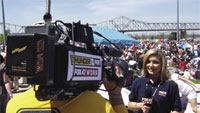WDRB-TV in full HD

Every spring, Louisville, KY, hosts an event called “Thunder Over Louisville,” which occurs two weeks before the Kentucky Derby. The event serves as the opening ceremonies of the Kentucky Derby Festival and attracts nearly one million attendees. Programming includes an air show in the afternoon and a fireworks display at night.
Each year, the festivities are aired by a different local TV station. This year's coverage was hosted by WDRB-TV, Fox-41, which decided to broadcast the event entirely in HD, a first for this program. HD production was provided by F&F Productions, which deployed 22 HD cameras in strategic locations on both sides of the Ohio River.
This year's fireworks presentation occurred on the Ohio River. The station positioned five HD cameras nearly 5000ft across the river. This created a new set of challenges that needed to be solved. Additionally, the station's news director, Barry Fulmer, wanted to use a roving/nontethered HD camera to obtain a shot of the spectators and a skyscraper camera shot that normally would have required the street being blocked off to fly triax up 300ft.
Sky's the limit
To address these concerns, WDRB's engineering team turned to Nucomm and its digital microwave technology. While performing a roving camera shot in analog would ordinarily be an easy task, using this method to capture all of the action in HD was much more difficult. To tackle this obstacle, the broadcast team chose Nucomm's CamPac2 HD/SD wireless microwave transmitter unit, equipped with an omnidirectional antenna.
The camrea's wireless link included an integrated MPEG HD encoding and variable bandwidth COFDM modulation that was used to build a mechanical roving reporter. The unit, set for 16MHz, 16-QAM, transmitted a 36Mb/s HD signal to a quad sector antenna. That antenna was mounted on the handrail of the 2nd Street Bridge, where a Newscaster DR quad diversity receiver working on Channel 2 at 2GHz was connected via fiber to the production truck, which was parked 2500ft away on 4th Street. The CamPac2 transmitter block was fed with a standard HD-SDI video stream and analog line level audio that was embedded from the field reporter's wireless microphone.
Using the wireless transmitter allowed WDRB to embed the audio and perform the various levels of necessary compression in order to comply with the 2GHz channel boundaries presented within one lightweight pack. This eliminated the need for lugging heavy, cumbersome encoders typically used for HD-SDI to ASI conversion.
Get the TV Tech Newsletter
The professional video industry's #1 source for news, trends and product and tech information. Sign up below.
Roving cameras were used to overcome the 3500ft between the crowds and the production truck. With the bridge receive site 2500ft from the production truck, a set of Stratos fiber-optic units provided by Bexel transmitted an HD-SDI signal back to the truck. One set of these units (a transmitter and receiver combo) can transport a single ASI or HD-SDI stream over fiber. The fiber was single mode, 9 microns with ST connectors.
To properly capture the F16 fighters in the air show, the team established a camera shot from the 300ft-tall Humana Tower, which was 1500ft from the production truck. Instead of enduring many hours of pulling triax, this setup was easily achieved in an hour's time using Nucomm's Channel Master TX1 transmitter and companion RX1 receiver. This portable link provided HD in ASI format back to the truck.
Sparking communication
The signals from the other 17 cameras were transported back to the truck using either triax or 15,000ft of fiber optics. For the fibered cameras, F&F Productions used Telecast Fiber Systems SHED and HDX units. The HDX unit converts the camera signals from HD-SDI to fiber, and the SHED converts the optical signal back to HD-SDI. One of the strongest features of these fiber units is that all cameras had full CCU control, including intercom. The locations across the river that had talent also had an extra audio channel. Two fibers were allocated for each camera location, and WDRB had two extra fibers in the run for each camera location in case problems arose.
Thunderous applause
At the end of the production, WDRB was extremely pleased with the performance and the quick setup of the Nucomm microwave links. The equipment is made to last, as it features a military-style and water-resistant architecture. The hardware has a robust design that is durable and user-friendly. Navigating through the menus for switching channels or data rates was easily performed without research or reference.
Gary Schroder is chief engineer at WDRB-TV, Fox-41, in Louisville, KY, and WMYO-TV, a My Network affiliate, in Salem, IN.
